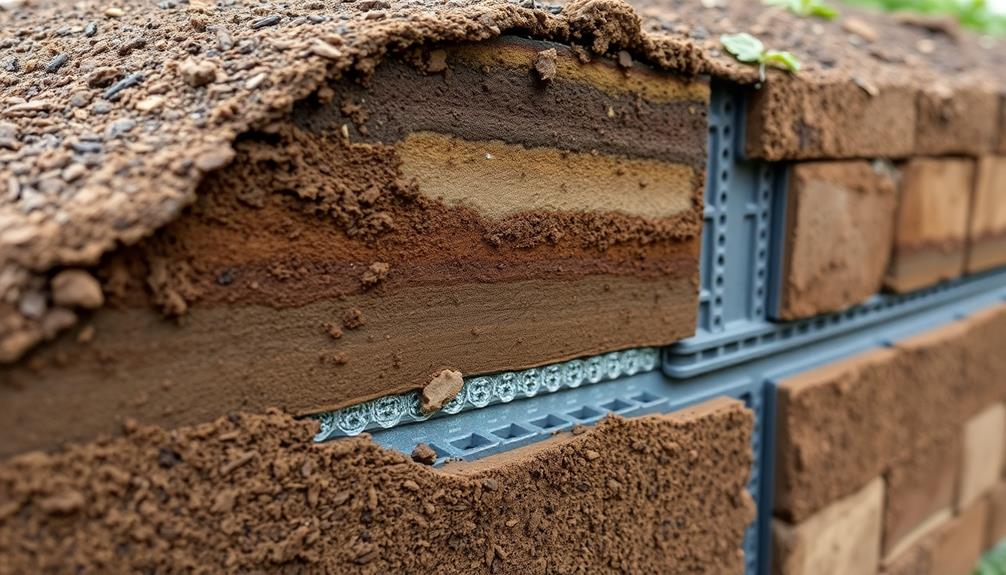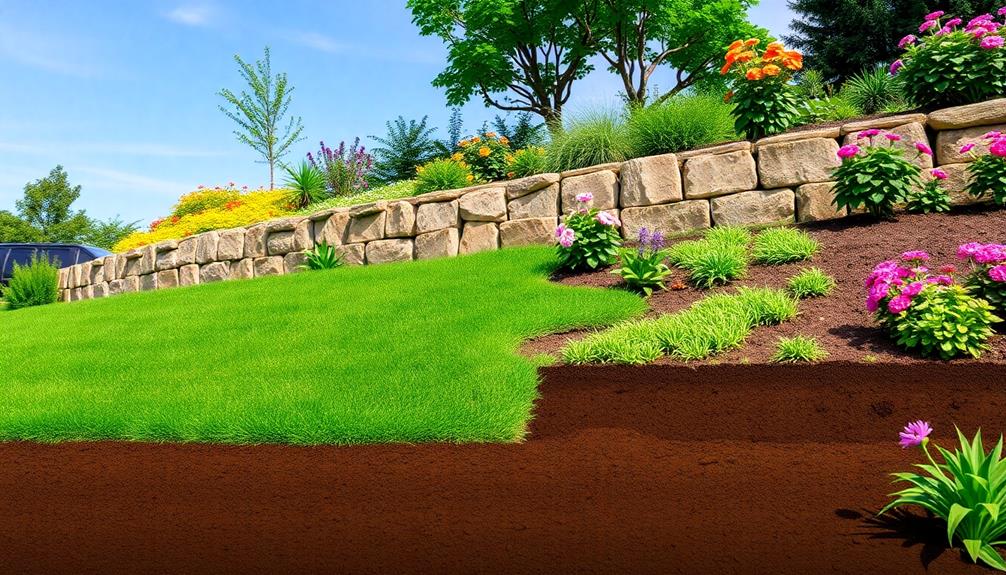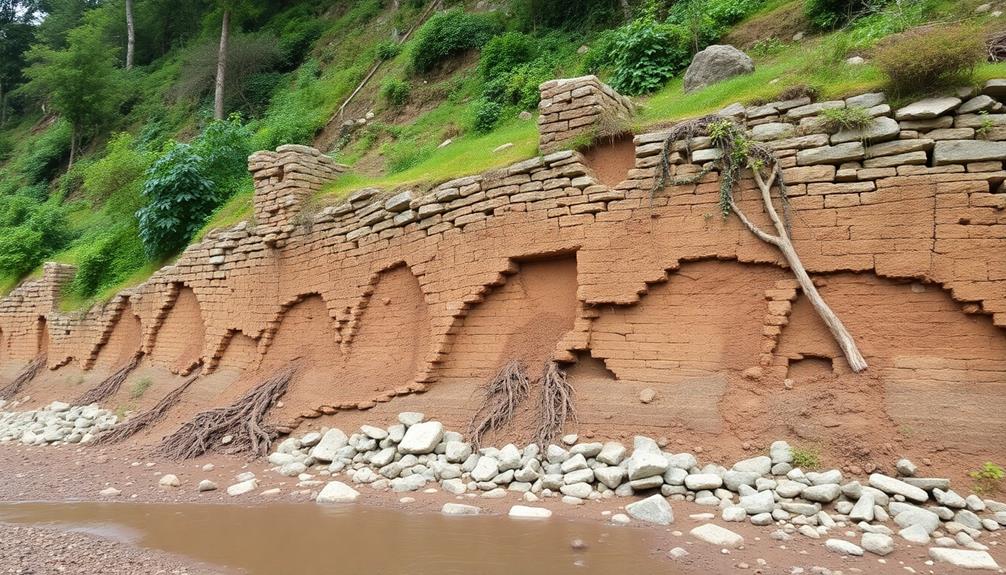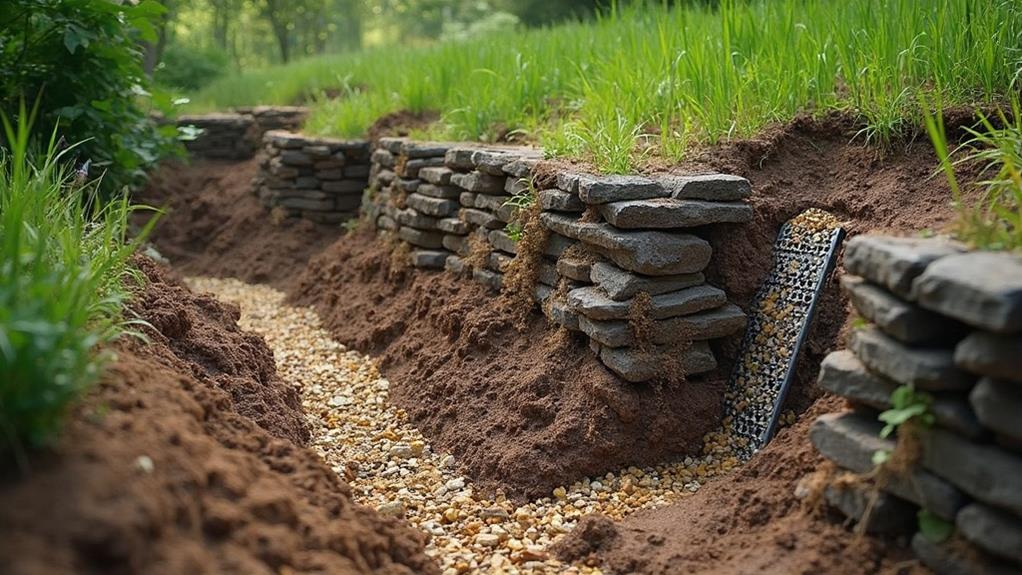In retaining wall design, understanding soil composition and ensuring effective drainage are pivotal to structural integrity and longevity. Different soil types, such as granular or cohesive, dictate characteristics like bearing capacity and cohesion, impacting the wall's stability. Proper soil analysis aids in designing a wall that can withstand environmental stresses. Drainage solutions are essential as they prevent hydrostatic pressure buildup, which can lead to structural failures. By managing water efficiently, the wall's robustness and landscape aesthetics are preserved, reducing maintenance needs. As you explore further, you'll gain deeper insights into optimizing retaining wall design through nuanced soil and drainage considerations.
Table of Contents
ToggleWalls Contractor Highlights
- Proper soil selection prevents structural failures by ensuring load-bearing capacity and cohesion in retaining walls.
- Efficient drainage systems alleviate hydrostatic pressure, reducing the risk of wall failure.
- Good water management promotes soil stability, extending the wall's lifespan and structural integrity.
- Soil and drainage considerations significantly enhance the wall's ability to withstand environmental pressures and erosion.
- Addressing soil and drainage issues minimizes maintenance costs and ensures long-term landscape appeal.
Understanding Soil Structure

Understanding the intricacies of soil structure is paramount in the effective design of retaining walls. This involves a thorough analysis of types of soil composition, which directly influences load-bearing capacities.
The stability of the soil is contingent on various factors such as moisture content, particle size, and the presence of organic material, all of which determine the reliability and longevity of these structures. Additionally, evaluating site conditions such as topography and existing soil characteristics is essential for selecting the appropriate retaining wall materials.
Furthermore, incorporating strategies for soil erosion prevention is indispensable, as this not only affects the structural integrity of the wall but also minimizes environmental impacts, ensuring a sustainable design approach.
Types of Soil Composition
A critical understanding of soil composition is essential for effective retaining wall design. Soil composition refers to the different materials that make up soil, including mineral particles, organic matter, water, and air. These elements together dictate the soil's physical and chemical characteristics, such as texture, density, permeability, and cohesion, all paramount factors in supporting a stable retaining structure. Professionals often categorize soil into three primary types—granular, cohesive, and organic—each presenting unique behaviors and challenges.
Granular soils, such as sand and gravel, are composed of larger particles and possess high permeability, enabling efficient water drainage but providing minimal cohesion. In contrast, cohesive soils, like clay, are characterized by fine particles and significant cohesion, which can inhibit drainage and increase lateral pressure against retaining walls.
Organic soils, rich in decomposed plant material, often suffer from compressibility and instability, making them less desirable for construction purposes.
A nuanced understanding of these soil types and their innate characteristics allows engineers and architects to make informed decisions, thereby enhancing the durability and efficiency of retaining wall projects. Integrating this knowledge into retaining wall design guarantees landscape harmony, aligns with community standards, and fosters a sense of belonging through aesthetically pleasing and functional structures.
Soil Stability Factors
In addition to soil composition, factors influencing soil stability play a pivotal role in the design of retaining walls. Understanding the structure and behavior of soil is fundamentally linked to how well these barriers will perform over time.
Several variables contribute to soil stability, including moisture content, compaction, and the presence of organic matter. These elements interconnect to affect the soil's capacity to support structural loads, resist pressure, and maintain its form under varying conditions.
Compacted soil is typically more stable, as it provides a dense substrate that can impede water flow and resist shifting. On the other hand, excessive moisture levels within soil can lead to reduced friction between particles, increasing the risk of movement that can compromise wall integrity.
Organic matter, while beneficial for plant growth, can affect soil consistency and contribute to instability if not adequately managed.
For those involved in constructing or maintaining retaining walls, awareness and evaluation of these soil stability factors are essential. Ensuring proper assessment and adjustment in design to accommodate these variables will not only increase structural longevity but also provide peace of mind in knowing the structure stands on a solid foundation.
Soil Erosion Prevention
Preventing soil erosion is a critical aspect of maintaining the effectiveness and longevity of retaining walls. Understanding soil structure is foundational to this endeavor, as it informs both the design and the preventative measures necessary for erosion management. Soils are comprised of varying proportions of sand, silt, clay, and organic matter, each contributing distinct characteristics such as permeability and cohesion. Retaining wall designs must consider these properties to implement strategies that stabilize the soil, ensuring it remains intact behind the wall.
Proper assessment of soil textures and composition aids in selecting the correct drainage techniques and materials, which are pivotal in minimizing erosion risks. Effective soil erosion prevention includes implementing adequate drainage systems, which alleviate hydrostatic pressure and enhance soil stability. Perforated pipes, gravel backfills, and geotextiles are often employed to facilitate water movement away from the wall, preserving the soil's structural integrity.
Incorporating vegetation can further anchor the soil particles, minimizing displacement and nutrient loss. By integrating these considerations into the design phase, communities can uphold the resilience of retaining walls, thus strengthening not only their landscapes but also the sense of security and connectedness shared by individuals who rely on these structures.
Benefits

Properly designed retaining walls offer numerous benefits, with paramount importance placed on preventing structural failures by providing the necessary support against soil pressure, thereby boosting the longevity of the supported structures considerably.
These walls also aid in creating usable areas for gardens, patios, and other features by effectively keeping soil in place. Engineered to promote efficient drainage systems, a critical factor in minimizing erosion risks, they allow water to flow away from vulnerable areas.
Prevents Structural Failures
Ensuring the integrity of a retaining wall is paramount in preventing structural failures that could lead to costly repairs and safety hazards. Central to this integrity is the careful consideration of soil composition and drainage systems, which collectively fortify the wall against the relentless forces of nature.
Poorly managed water accumulation, resulting from inadequate drainage solutions, can greatly increase hydrostatic pressure behind the wall. This pressure, over time, might exploit the inherent weaknesses in the structure, culminating in a failure that could prove devastating.
In addition, the choice of soil plays an instrumental role in maintaining the structural soundness of the wall. Soil that is too loose or composed of materials prone to erosion can destabilize the wall's foundation, paving the way for subsidence or collapse. Engineering principles emphasize the need for accurate soil assessments and strategic soil enhancements to counterbalance these natural tendencies.
Implementation of state-of-the-art drainage solutions such as French drains or weep holes, in conjunction with the diligent selection of soil with ideal bearing capacity, crafts a synergy that upholds the wall's resilience. As a result, an informed approach that integrates soil and drainage considerations fortifies retaining walls, safeguarding both property and peace of mind.
Enhances Longevity Significantly
Achieving structural integrity is a fundamental objective in retaining wall design, and it simultaneously paves the way for enhanced longevity. By diligently considering the role of soil composition and excellent drainage pathways, one can create a robust design that not only withstands various environmental pressures but also endures the test of time.
The longevity of a retaining wall is directly linked to its ability to resist natural forces, and here, the properties of the soil and proper engineering greatly influence the wall's long-term survival.
The selection of appropriate soil types—those known for their load-bearing capacity and cohesion—guarantees the wall can efficiently distribute stress, preventing undue strain. Additionally, when the substrate's characteristics are harmonized with the structural materials used in the wall itself, unexpected failures are less likely, thereby extending the wall's lifespan. The careful analysis of these soil properties informs the depth, width, and overall design specifications of the wall, safeguarding its endurance beyond initial expectations.
Incorporating these critical elements guarantees that the retaining wall remains functionally sound within its environment, consequently fostering a sense of belonging for the communities that rely on its strength and durability for safety and aesthetic purposes.
Promotes Efficient Drainage
Efficient drainage is a cornerstone of effective retaining wall design, directly impacting both the structure's stability and longevity. By promoting efficient drainage, retaining walls can effectively handle the pressures exerted by water accumulation, providing a robust solution to potential structural failures. This vital aspect functions as both a proactive and protective measure, ensuring the wall's performance and extending its service life.
To foster a sense of community and shared knowledge, consider the essential benefits of ensuring proficient drainage in retaining walls:
- Prevents Hydrostatic Pressure: Proper drainage reduces water build-up behind the wall, preventing harmful pressure that can lead to structural damage.
- Enhances Soil Stability: By efficiently channelling water away, the stability of the soil surrounding the wall is maintained.
- Increases Structural Integrity: Consistent water removal contributes to the wall's overall strength and durability.
- Augments Aesthetic Value: Proper water management preserves landscaping efforts, sustaining the visual appeal of the surrounding area.
- Reduces Maintenance Needs: Addressing drainage minimizes water-related wear and tear, leading to lower repair requirements.
In this way, by integrating efficient drainage solutions into retaining wall design, both functional and aesthetic needs are met, fostering both a reliable structure and a harmonious integration into its environment.
Minimizes Erosion Risks
Often overlooked in retaining wall design, minimizing erosion risks is crucial for maintaining the wall's long-term stability and surrounding landscape. Erosion can systematically undermine the structural integrity of retaining walls, leading to costly repairs and potentially hazardous conditions. By understanding the interplay between soil composition and water management, retaining wall design can incorporate features that substantially reduce erosion threats. Proper grading and the integration of strategic drainage solutions are necessary components. These approaches not only protect the wall but also preserve the natural beauty and function of the landscape as a unified whole.
Incorporating erosion control measures in the initial design phase is indispensable. Techniques like installing geotextiles to separate soil layers and using plants with robust root systems can reinforce soil stability, reducing erosion potential. The selection of materials such as permeable aggregates in backfill areas facilitates water movement, preventing waterlogged soil that may shift or collapse. Additionally, the use of retaining wall blocks with interlocking systems enhances structural cohesion. Such design considerations ensure that both the wall and the surrounding environment are protected, fostering a sense of harmony and balance with the natural elements, thereby satisfying the fundamental needs of safety and aesthetics.
Historical Construction Failures

Examining historical construction failures provides pivotal insights into the challenges faced by ancient engineers, whose structural collapses often led to tragic loss and prompted a reevaluation of building practices. By understanding where these early projects faltered, modern engineering has been substantially informed, leading to groundbreaking advancements that enhance the reliability and safety of contemporary retaining wall designs. The following table highlights key historical failures, their causes, and lessons that have shaped today's engineering practices:
| Historical Failure | Cause of Collapse | Lessons Learned |
|---|---|---|
| Roman Aqueduct | Poor Foundation Stability | Necessity of Soil Analysis |
| Leaning Tower of Pisa | Uneven Soil Settlement | Importance of Load Distribution |
| Teton Dam | Inadequate Material Testing | Rigorous Construction Standards |
Ancient Structural Collapses
Throughout history, the ingenuity of architects and builders has shaped the world, yet not every structure has withstood the test of time. Ancient structural collapses serve as poignant reminders of the impact of inadequate knowledge and technique in construction.
These failures often resulted from challenges related to soil and drainage, which remain central to structural integrity. They demonstrate the timeless necessity of considering geological factors in design and are emblematic of how the natural environment can influence human achievements.
Various notable ancient structural collapses highlight these vulnerabilities:
- The Leaning Tower of Pisa: This iconic symbol of foundation settling due to incompatibility with surrounding soil.
- The Colossus of Rhodes: Succumbing to seismic activity, this example illustrates weak structural resilience.
- King Menes' Dam: Its failure emphasized the importance of understanding the hydrology and soil mechanics in civil design.
- The Temple of Artemis: Moisture-related ground issues led to its instability, compromising its grandeur.
- Troy's Walls: Allegedly fell due to undermined subsoil, cautioning historic builders on the pernicious threat of neglecting drainage.
Each incident underlines the need for rigorous geotechnical assessments, fostering respect for solid construction principles and a deeper communal appreciation of our built heritage.
Lessons From Past Failures
The examination of ancient structural collapses underscores the lessons modern engineers and architects must heed to avoid repeating past mistakes. Numerous historical failures, from Roman aqueducts to medieval fortifications, provide invaluable insights into the critical role of soil and drainage in retaining wall design. Past catastrophes often stemmed from overlooking soil stability and moisture management, leading to devastating outcomes. Inadequate understanding of soil properties or neglecting drainage provisions resulted in structural instability and eventual collapse. These unfortunate events reveal the need for thorough site assessments and climate considerations integral to modern construction practices.
One prominent example includes the Tay Rail Bridge disaster of 1879, where misjudged soil conditions and insufficient bracing led to the structure's tragic failure. Such historical precedents emphasize that sustainable designs require more than architectural prowess—they demand a rigorous analysis of soil mechanics and hydrological patterns. Professionals today must integrate these reflections with modern methodologies, fostering a discipline that acknowledges shared knowledge and collaborative growth. As a community of engineers and designers, recognizing and respecting the wisdom gleaned from past experiences guarantees that structures can endure, fostering a sense of belonging in a world reliant on the strength and safety they provide.
Engineering Advancements Learned
Learning from historical construction failures has facilitated significant engineering advancements, transforming the field of retaining wall design. These advancements underscore the importance of incorporating lessons from past mishaps to create structures that are both resilient and enduring. By analyzing failures such as the collapse of inadequately designed walls due to poor drainage or unstable soils, engineers today are better equipped to address these challenges.
Key engineering advancements include:
- Improved soil analysis techniques, allowing for more accurate assessments of soil stability and composition, guaranteeing that the selected design matches site conditions.
- Enhanced drainage solutions, which mitigate water pressure buildup behind walls, thereby preventing potential structural failures.
- Advanced materials and geotechnical textiles, which provide additional support and adaptability to varying environmental conditions.
- Sophisticated design software, enabling precise modeling of load-bearing capacities and structural stresses, offering a more reliable prediction of a wall's performance over time.
- Integrated monitoring systems, which continuously assess structural integrity, notifying of any changes that could compromise safety.
These advancements contribute to a sense of belonging among communities that depend on reliable infrastructure. By learning from the past, engineers guarantee that retaining walls serve their intended purpose, safeguarding both property and lives while fostering a sense of safety and community continuity.
Walls Contractor FAQ
How Do Different Soil Types Affect Retaining Wall Stability?
Soil type profoundly influences retaining wall stability by dictating load conditions and drainage efficiency. Cohesive soils offer better stability, whereas granular soils allow water transmission, affecting wall pressure. Consequently, understanding soil properties fosters stronger community-focused design solutions.
What Role Does Climate Play in Drainage Design for Retaining Walls?
Climate profoundly influences drainage design by dictating precipitation patterns, temperature fluctuations, and freeze-thaw cycles. Effective drainage solutions guarantee community safety and resilience, fostering inclusivity and connection through shared commitment to sustainable and durable infrastructure development.
Can Vegetation Impact the Structural Integrity of Retaining Walls?
Vegetation can greatly influence retaining wall stability. Root systems provide soil reinforcement but can also induce pressure against the wall, leading to potential damage. As a result, selecting compatible plant species is paramount for integrated landscape and structural harmony.
How Often Should Retaining Walls Be Inspected for Drainage Issues?
Retaining walls should be inspected annually for drainage issues to guarantee long-term stability and prevent structural damage. Regular assessments foster a sense of community safety and accountability, enhancing our shared spaces' reliability and resilience.
What Modern Techniques Are Available for Improving Drainage in Retaining Wall Construction?
Modern techniques for enhancing drainage in retaining wall construction include the implementation of geosynthetics, which prevent soil erosion and improve water flow, and the use of perforated pipes and drainage boards to effectively channel excess water away.







